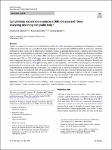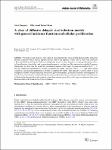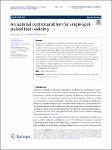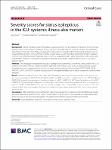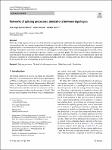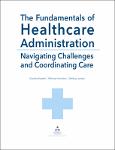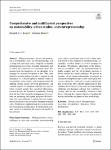Search
Author
- Osman, Ahmed I. (5)
- Daqing, Ma (3)
- Jorgensen, Ed (3)
- Li, Yan (3)
- next >
Subject
- kinh tế (26)
- Economics (12)
- programming (10)
- XRD (10)
- next >
Date issued
- 2020 - 2025 (2128)
- 2010 - 2019 (129)
- 2000 - 2009 (9)
- 1999 - 1999 (1)
Has File(s)
Search Results
The tensor rank decomposition, or canonical polyadic decomposition, is the decomposition of a tensor into a sum of rank-1 tensors. The condition number of the tensor rank decomposition measures the sensitivity of the rank-1 summands with respect to structured perturbations. Those are perturbations preserving the rank of the tensor that is decomposed. On the other hand, the angular condition number measures the perturbations of the rank-1 summands up to scaling. We show for random rank-2 tensors that the expected value of the condition number is infinite for a wide range of choices of the density. |
Updating an abstract Voronoi diagram in linear time, after deletion of one site, has been an open problem in a long time; similarly, for any concrete Voronoi diagram of generalized (non-point) sites. In this paper we present a simple, expected linear-time algorithm to update an abstract Voronoi diagram after deletion of one site. To achieve this result, we use the concept of a Voronoi-like diagram, a relaxed Voronoi structure of independent interest. Voronoi-like diagrams serve as intermediate structures, which are considerably simpler to compute, thus, making an expected linear-time construction possible. |
We introduce a large class of concentrated p-Lévy integrable functions approximating the unity, which serves as the core tool from which we provide a nonlocal characterization of the Sobolev spaces and the space of functions of bounded variation via nonlocal energies forms. It turns out that this nonlocal characterization is a necessary and sufficient criterion to define Sobolev spaces on domains satisfying the extension property. We also examine the general case where the extension property does not necessarily hold. In the latter case we establish weak convergence of the nonlocal Radon measures involved to the local Radon measures induced by the distributional gradient. |
Inspired by a paper by Teseletso and Adachi (Miner Econ 8(10):21, 2021), the hypothesis regarding the declining grade of mined copper ore and its possible use as a guide to the future of ultimate recoverable resources (URRs) is tested. As a time axis, cumulative production is taken. Grades can be either grade of cumulative tonnage or annual production grade. Correlation can be linear (grade and tonnage) or semi-logarithmic (grade linear, tonnage logarithmic). We first show that the assumption that the highest correlation is the best guide to the future may be a fallacy. This is the linear correlation between grades of cumulative tonnage and cumulative tonnages since 1959, i.e., 85% of all copper mined historically with a near-perfect correlation approaching one (R2 = 0.97). This lea... |
We propose and analyze a new class of three dimensional space models that describes infectious diseases caused by viruses such as hepatitis B virus (HBV) and hepatitis C virus (HCV). This work constructs a Reaction–Diffusion-Ordinary Differential Equation model of virus dynamics, including absorption effect, cell proliferation, time delay, and a generalized incidence rate function. By constructing suitable Lyapunov functionals, we show that the model has threshold dynamics: if the basic reproduction number R0(τ)≤1, then the uninfected equilibrium is globally asymptotically stable, whereas if R0(τ)>1, and under certain conditions, the infected equilibrium is globally asymptotically stable. |
We consider an optimal control problem for a single-spot pulsed laser welding problem. The distribution of thermal energy is described by a quasilinear heat equation. Our emphasis is on materials which tend to suffer from hot cracking when welded, such as aluminum alloys. A simple precursor for the occurrence of hot cracks is the velocity of the solidification front. We therefore formulate an optimal control problem whose objective contains a term which penalizes excessive solidification velocities. The control function to be optimized is the laser power over time, subject to pointwise lower and upper bounds. |
Current prognostic scores for status epilepticus (SE) may not be adequate for patients in ICU who usually have more severe systemic conditions or more refractory episodes of SE. We aimed to compare the prognostic performance of two SE scores, Status Epilepticus Severity Score (STESS) and Epidemiology-Based Mortality Score in Status Epilepticus (EMSE) score, with four systemic severity scores, Acute Physiology and Chronic Health Evaluation 2 (APACHE-2), Simplified Acute Physiology Score 2 (SAPS-2), Sequential Organ Failure Assessment (SOFA) score, and Inflammation, Nutrition, Consciousness, Neurologic function and Systemic condition (INCNS) score in critically ill patients with SE. |
Networks of splicing processors are one of the theoretical computational models that take inspiration from nature to efficiently solve problems that our current computational knowledge is not able to. One of the issues restricting/hindering is practical implementation is the arbitrariness of the underlying graph, since our computational systems usually conform to a predefined topology. We propose simulations of networks of splicing processors having arbitrary underlying graphs by networks whose underlying graphs are of a predefined topology: complete, star, and grid graphs. |
This book is written for those interested in acquiring a thorough knowledge base relative to the intricacies of the organizational theories, customs, and insights significant to the management of health service organizations. It examines the foundational aspects of leadership and management as they relate to establishing and maintaining the principles and practices within healthcare organizations. The book opens with a discussion on the differences between health, healthcare, and health care while providing an overview of healthcare management and organizational trends. It culminates in discussions of leadership, management, motivation, organizational behavior, and management thinking. Additionally, it discusses topics of information technology, teamwork, health disparities, organiz... |
While practitioners discuss the phenomena of sustainability, cities, and entrepreneurship, such as living labs and smart cities, alongside sustainable entrepreneurial ecosystems at length, researchers tend to reduce the complexity by considering these phenomena from the perspective of one discipline or by merging two research disciplines at best. This study intends to provide guidance on what is required for the emergence of a transdisciplinary research stream of sustainability, urban studies, and entrepreneurship. By applying design science involving practitioners and scientific experts, we designed a relevant and rigorous future research agenda that considered phenomena, research design, and theoretical foundations. Starting from the basis that sustainable entrepreneurial ecosyste... |




